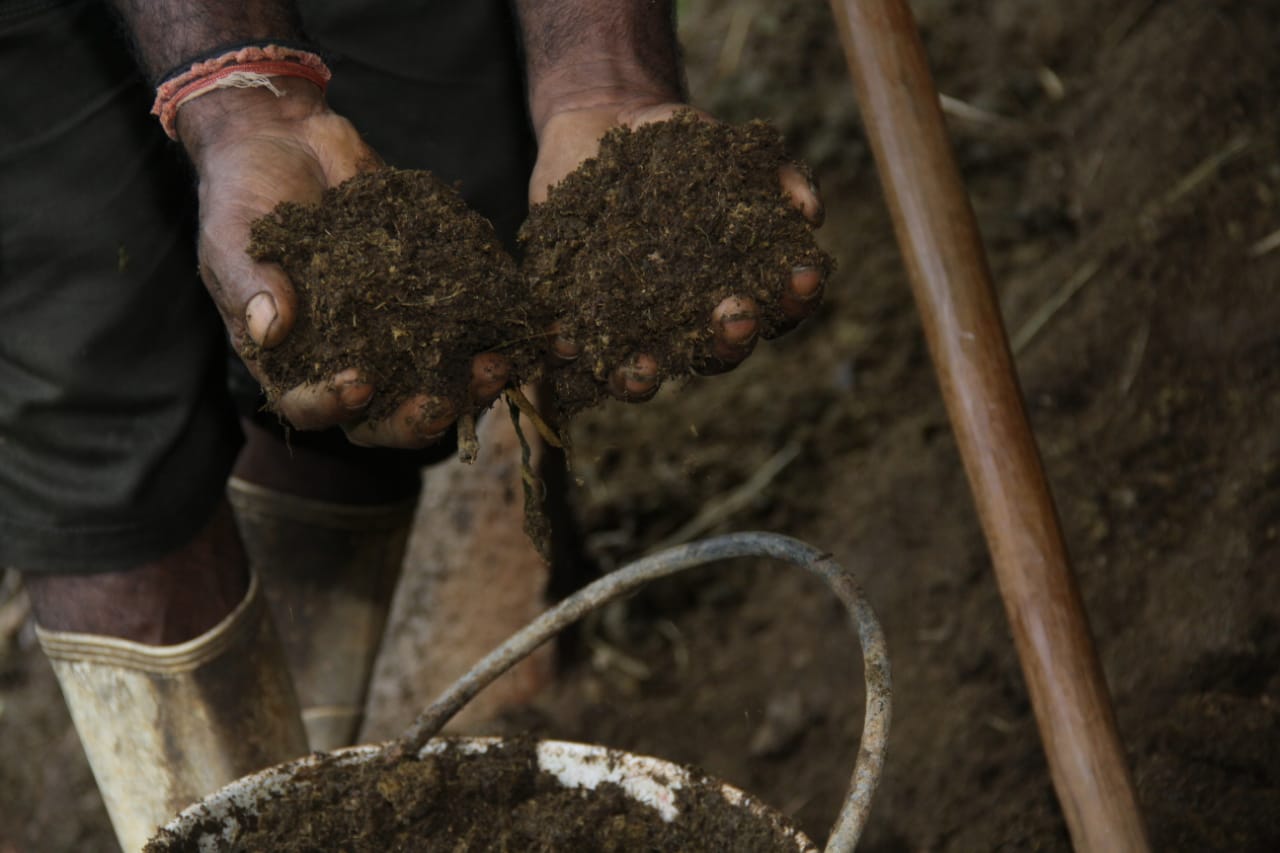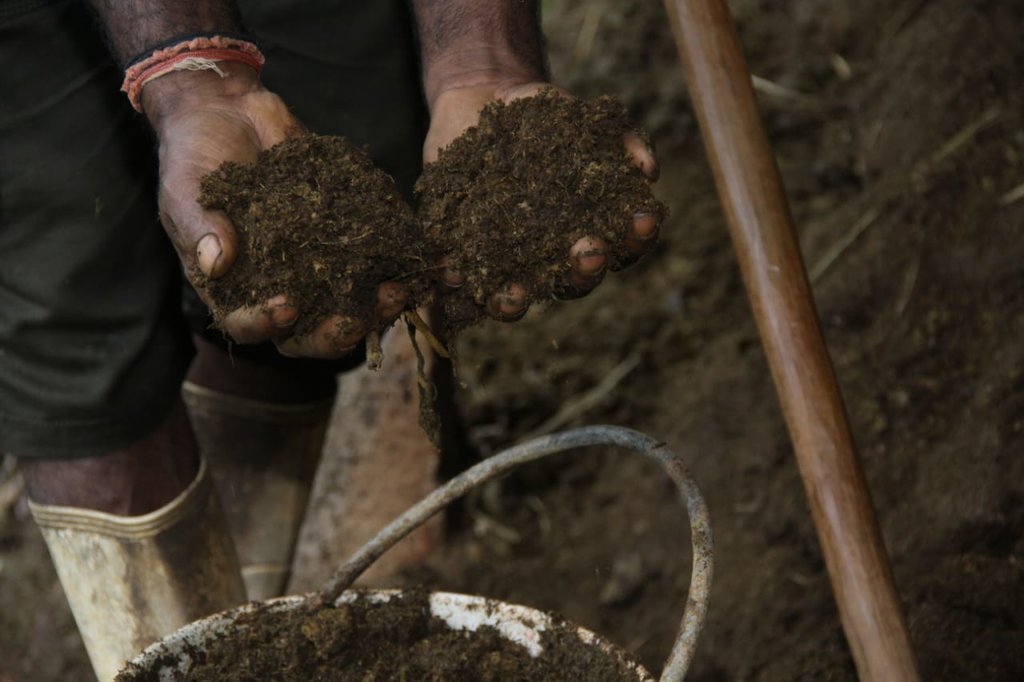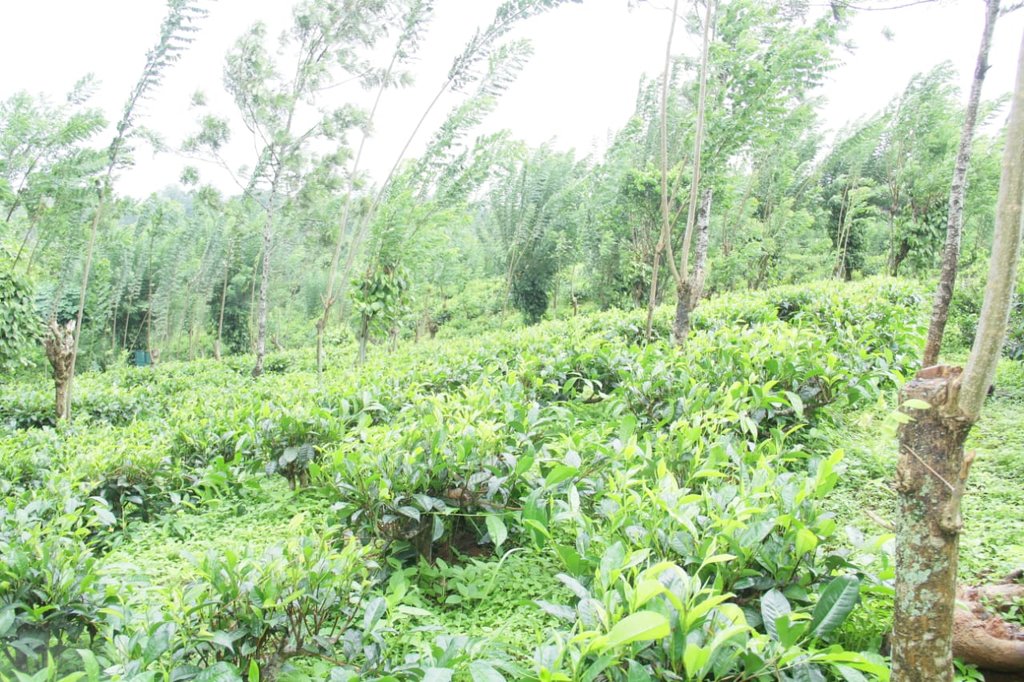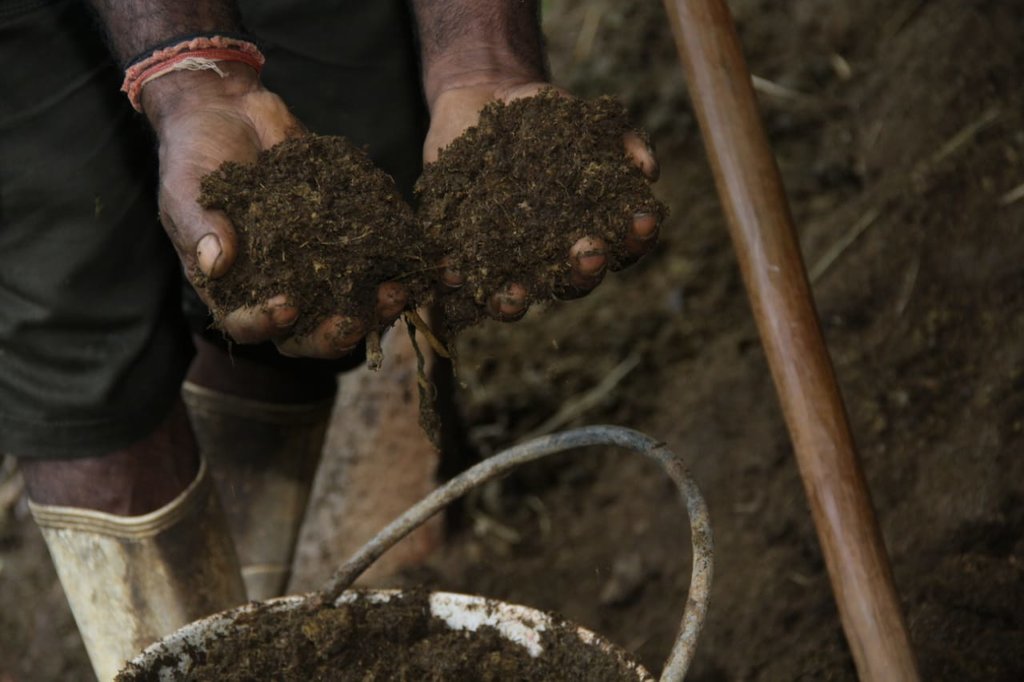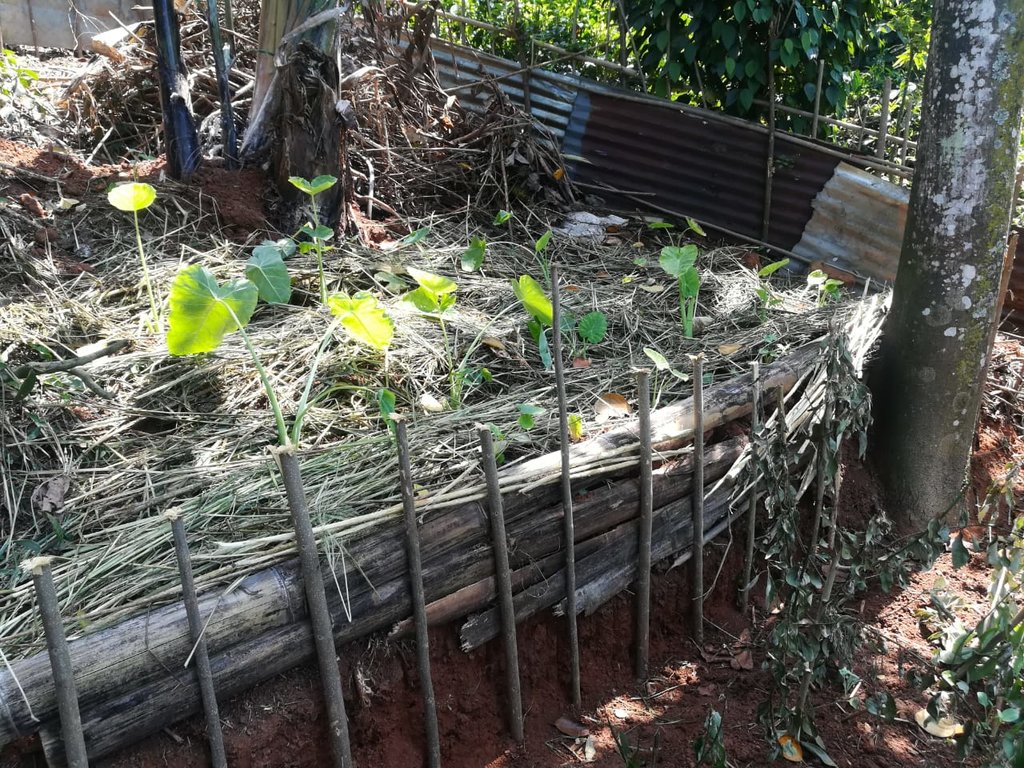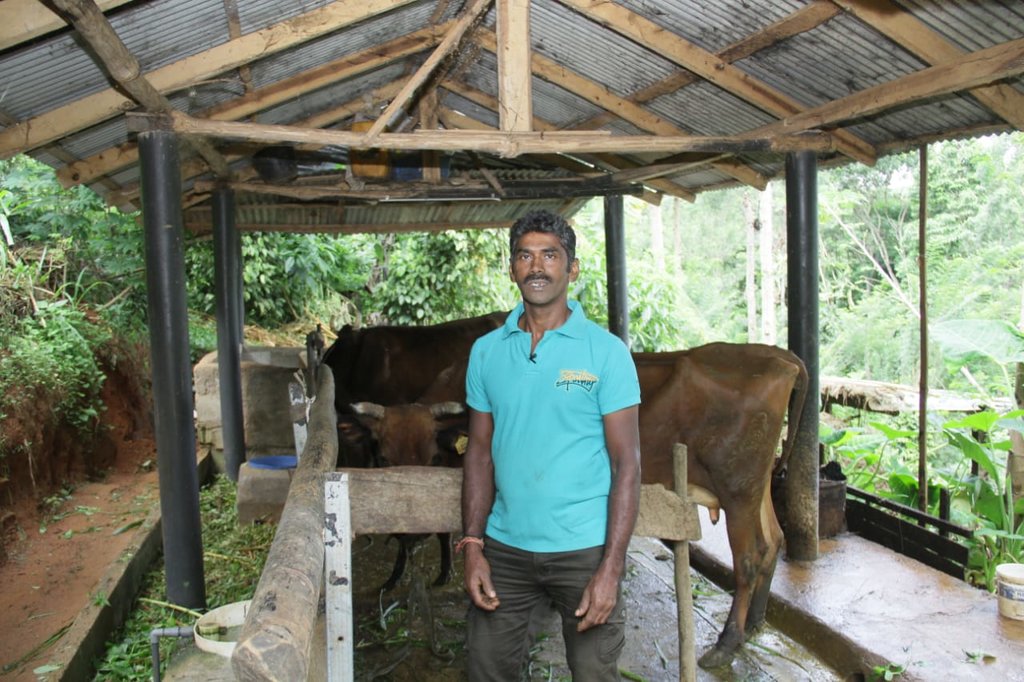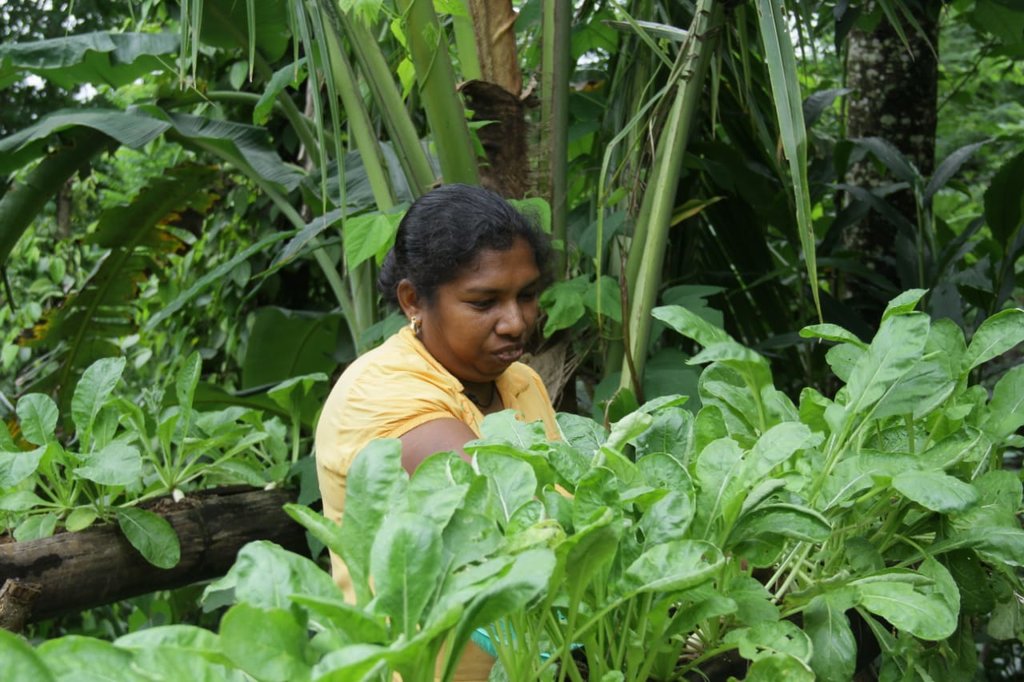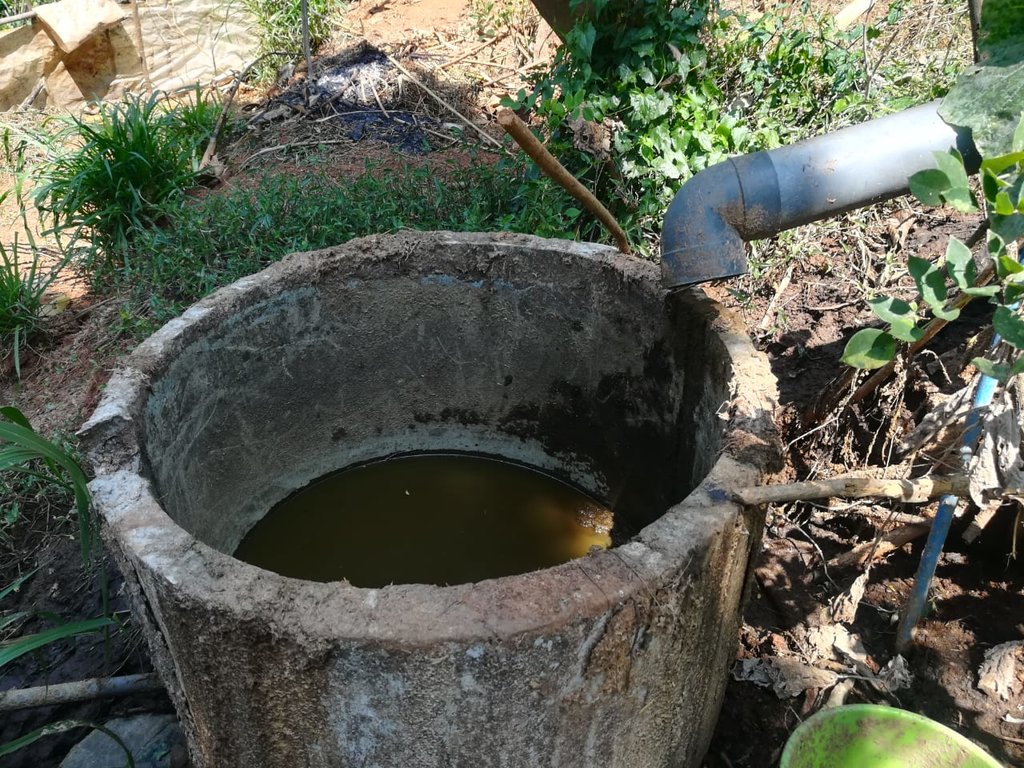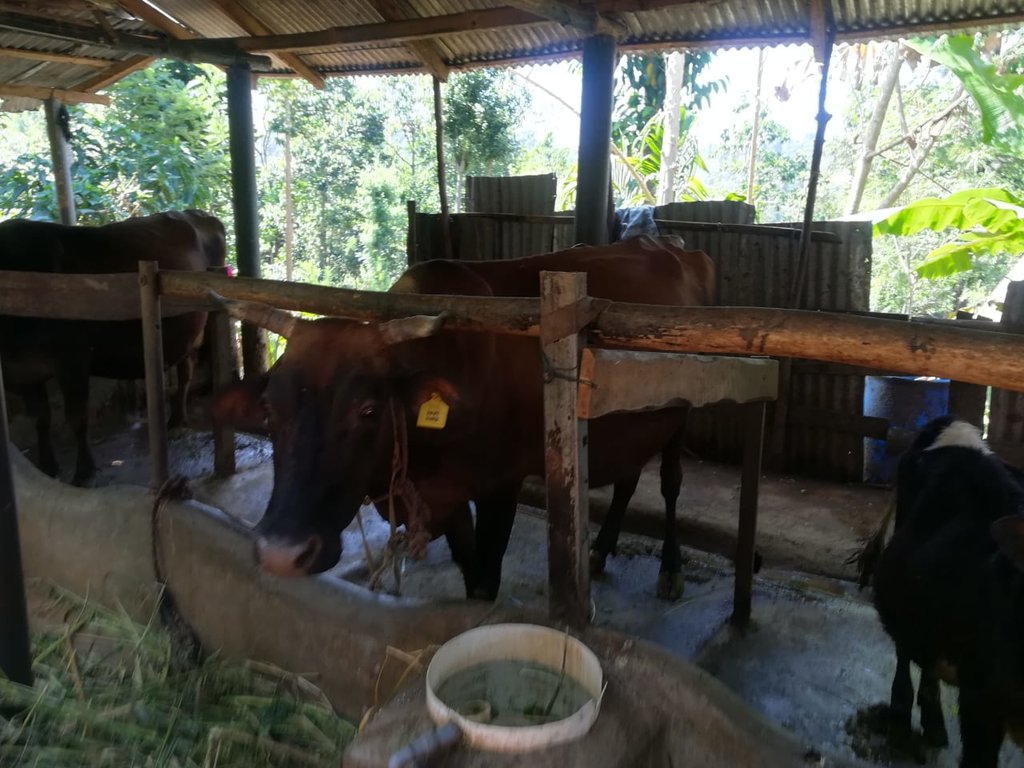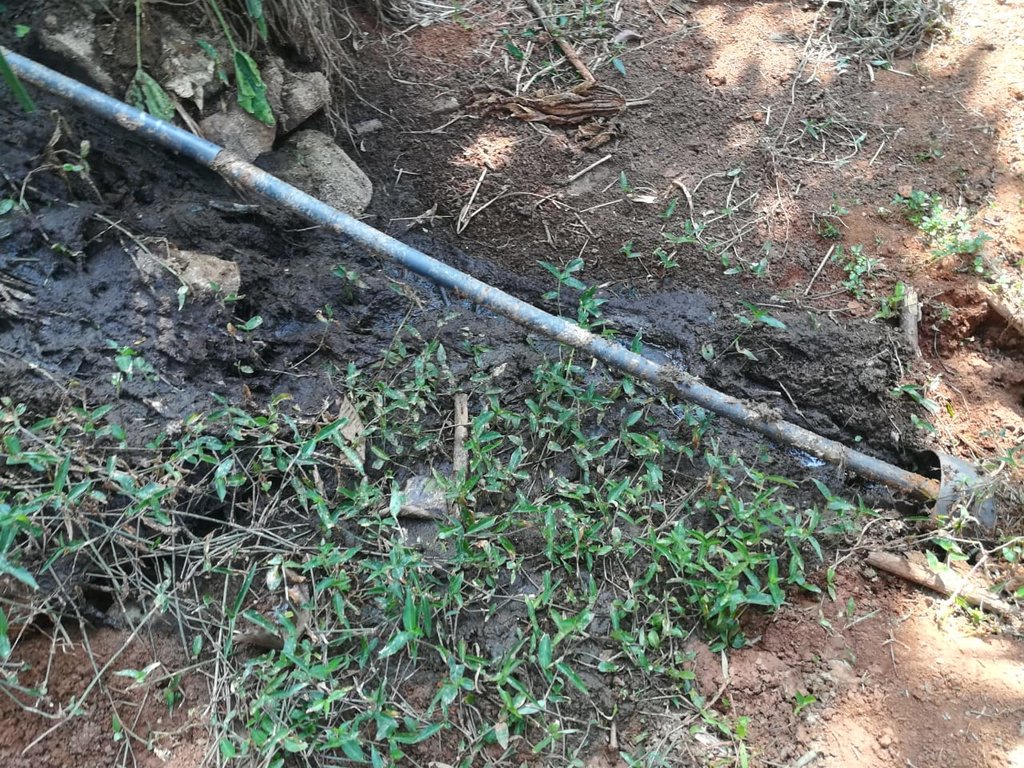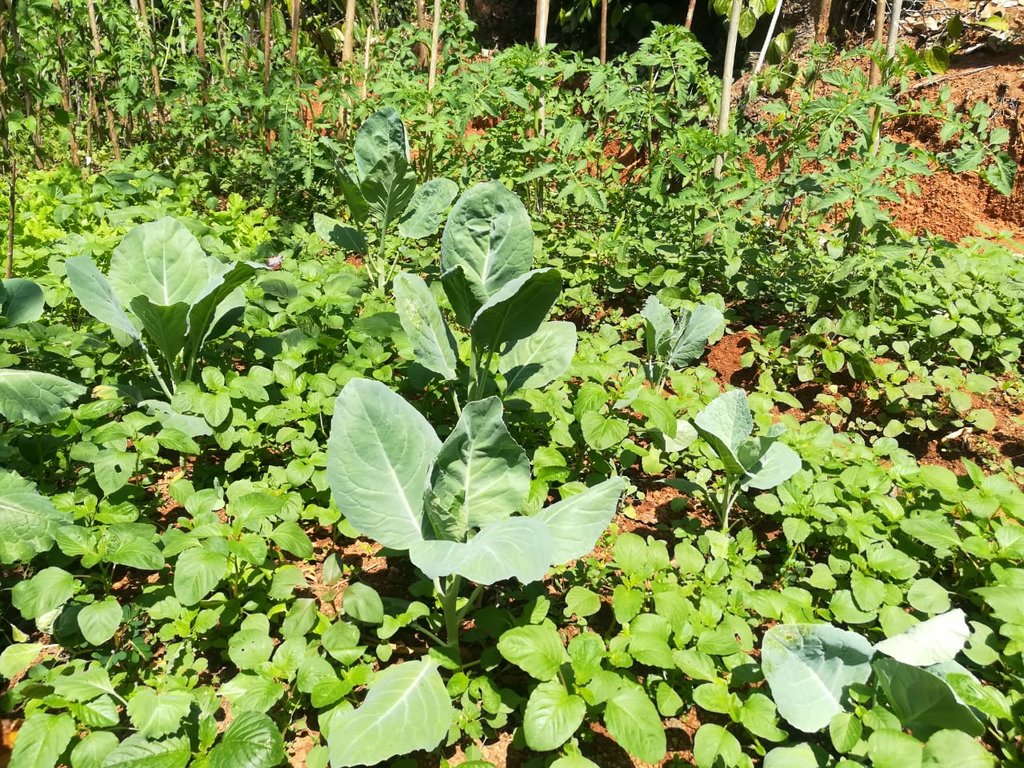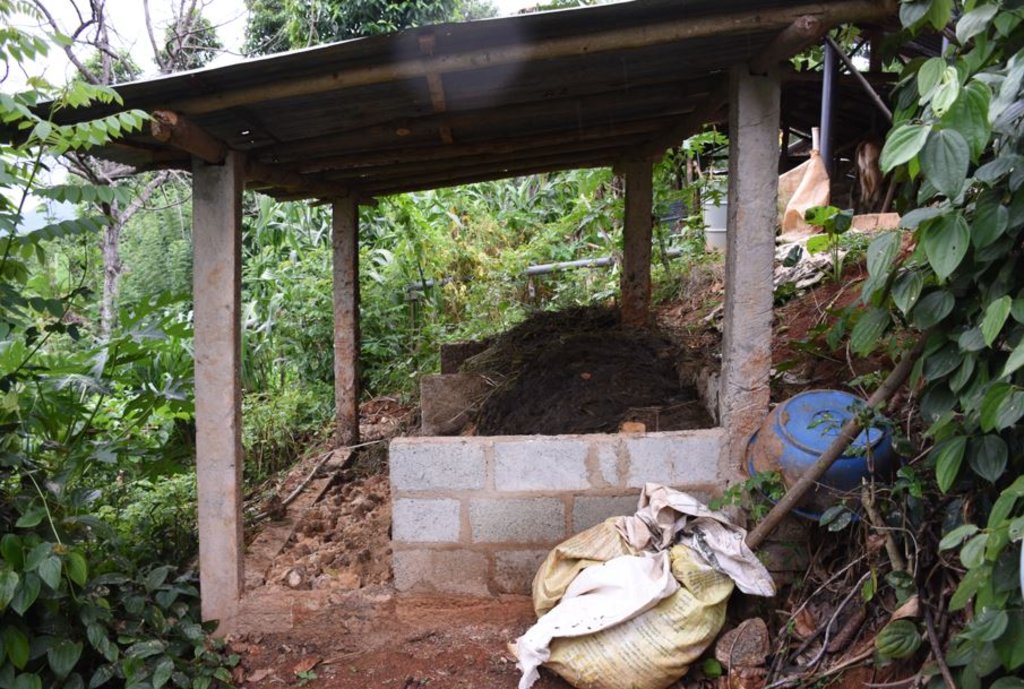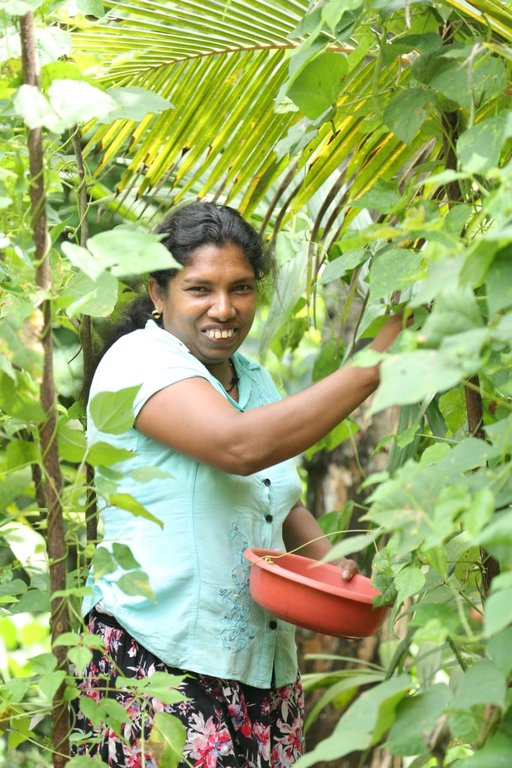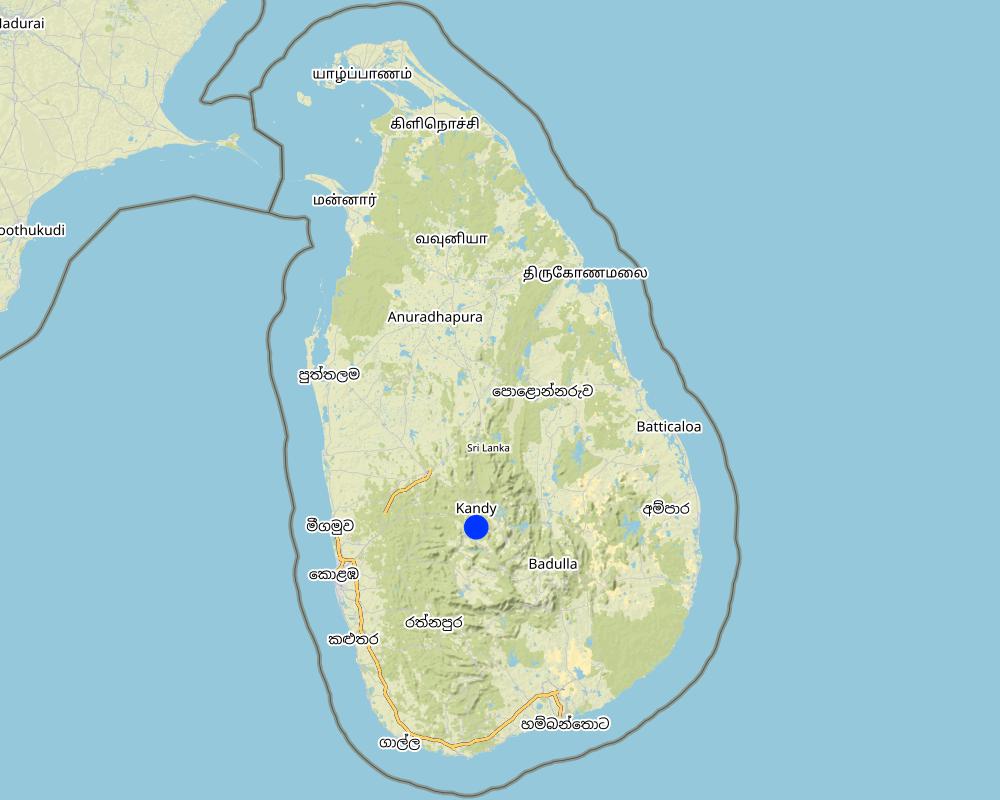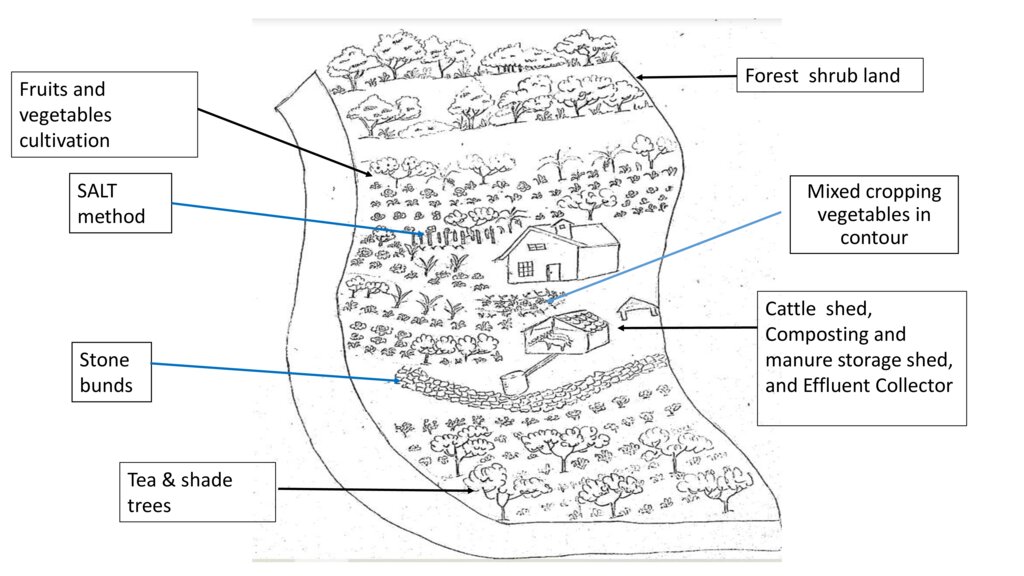Crop-livestock integration to enhance soil productivity [Sri Lanka]
- Creation:
- Update:
- Compiler: Head Soil Science
- Editor: –
- Reviewer: William Critchley
technologies_6236 - Sri Lanka
View sections
Expand all Collapse all1. General information
1.2 Contact details of resource persons and institutions involved in the assessment and documentation of the Technology
Key resource person(s)
land user:
Kallora Shantha
Sri Lanka
SLM specialist:
Gunasena Nimal
Sri Lanka
co-compiler:
Rajapaksha Chandi
Sri Lanka
co-compiler:
Beddegama Nilanthika
Sri Lanka
Name of project which facilitated the documentation/ evaluation of the Technology (if relevant)
Rehabilitation of Degraded Agricultural Lands in Kandy, Badulla and Nuwara Eliya Districts in the Central Highlands of Sri LankaName of the institution(s) which facilitated the documentation/ evaluation of the Technology (if relevant)
Faculty of Agriculture, University of Peradeniya, Sri Lanka (AGRI.PDN) - Sri Lanka1.3 Conditions regarding the use of data documented through WOCAT
The compiler and key resource person(s) accept the conditions regarding the use of data documented through WOCAT:
Yes
1.4 Declaration on sustainability of the described Technology
Is the Technology described here problematic with regard to land degradation, so that it cannot be declared a sustainable land management technology?
No
Comments:
Crop-livestock integration improves nutrient circularity, and soil productivity technology improves nutrient recycling and soil productivity in the land and SLM practices are reducing land degradation
1.5 Reference to Questionnaire(s) on SLM Approaches (documented using WOCAT)
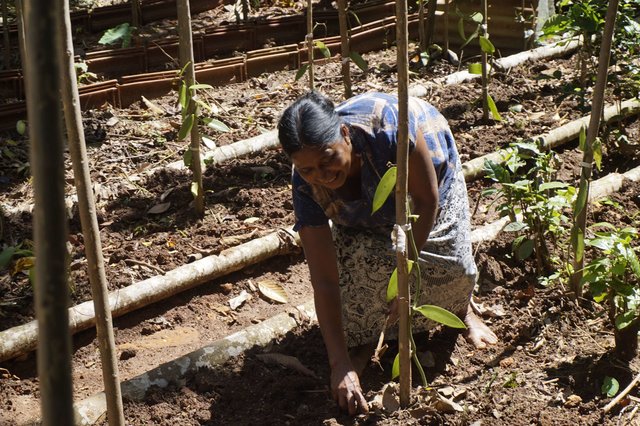
Women practices SLM through Vanilla cultivation [Sri Lanka]
Women in Central Highlands of Sri Lanka practice sustainable land management through vanilla cultivation and earn extra income for their families
- Compiler: Bandara Rotawewa
2. Description of the SLM Technology
2.1 Short description of the Technology
Definition of the Technology:
Crop-livestock integration improves nutrient circularity and soil productivity: solid and liquid organic fertilizers prepared from cow manure are incorporated to soil or sprayed on leaves of vegetables and tea.
2.2 Detailed description of the Technology
Description:
Dairy cattle farming is common in the Dolluwa area of the central province of Sri Lanka. Farmers typically have 3-4 cows on about 2-3 hectares for both milk consumption and sales. The landowner interviewed did not formerly adhere to best practices: cows were grazed in woodlands, and water and supplementary feed were not provided as needed. Housing was inadequate. Farm waste wasn’t properly recycled. The farm is located on steep land without adequate soil conservation for annual crops and tea. There was heavy dependence on chemical fertilizer. As a consequence, milk production was below average and crop yields had declined. Besides, there was reservoir pollution due to effluent washed downslope.
New technology was developed to increase milk and crop production by integrating animal–crop management strategies while enhancing nutrient circularity within the farm, and improving soil productivity and environmental quality.
The landowner was first enrolled in the Rehabilitation of Degraded Agricultural Land Project (RDALP) of the UN’s FAO in 2018. The first priority was soil conservation for the steep areas under tea. SLM practices thus combined contour cropping and bunding. Following this, an integrated crop-livestock system was initiated. The RDALP and Fonterra Pvt. Ltd. helped the landowner to build a modern cowshed with infrastructure to provide feed and water. Thereafter, cows were stall-fed: grazing was completely stopped. Cow manure is collected and stored in heaps for 2-3 weeks before incorporating into soils. In the same shed, compost is prepared by mixing manure with crop residues and kitchen/ homegarden waste. Cattle urine and wastewater is directed to a cement tank where it is mixed with specific types of leaves; it is fermented and applied as liquid fertilizer and biopesticide. Manure is used mainly for fast-growing vegetables, while compost is applied to annuals, particularly at planting, and to tea once every three months. Liquid fertilizer is applied to tea seven days before harvesting.
This package requires adequate land for a cattle shed, and for a recycling system to prepare compost and liquid fertilizers. In addition, there must be enough labour for the whole process. The key inputs include materials for the shed, associated infrastructure, and a sprayer to apply liquid fertilizers.
The major benefit is recycling waste to generate useful products – while ensuring circularity of nutrients between crop and animal production systems: thus supporting a “bioeconomy”. Soil conservation practices and the nutrient sources described have improved soil fertility and productivity for overall sustainability. Milk yields have more than doubled, and the tea harvest more than trebled.
(1) Where is the Technology applied?
On steep terrain: tea is cultivated lower down and there are reservoirs in the valley.
(2) What are the purposes/ functions?
•Provide food security
•Increase efficiency of livestock production
•Promote overall nutrient cycling
•Partially substitute chemical fertilizers and pesticides with organic manure
•Generate high-quality organic manure and compost to improve soil fertility
•Control contamination of river water
(3) What are the benefits/ impacts of the Technology?
•Reduced susceptibility of crops to pests/ diseases
•Improved quality of food and water
•Slowed land degradation and restored soil fertility
•Reduced risks
•Economically feasible and rapid impact
(4) What do land users like/
•Reduced risk
•Increased income
•Reduction in cost of production
(5) ...dislike
•Damage to crops by wild animals.
•Higher cost for dairy farming (feed)
2.3 Photos of the Technology
2.5 Country/ region/ locations where the Technology has been applied and which are covered by this assessment
Country:
Sri Lanka
Region/ State/ Province:
Central province
Further specification of location:
Dolluwa
Specify the spread of the Technology:
- applied at specific points/ concentrated on a small area
Is/are the technology site(s) located in a permanently protected area?
No
Map
×2.6 Date of implementation
Indicate year of implementation:
2019
If precise year is not known, indicate approximate date:
- less than 10 years ago (recently)
2.7 Introduction of the Technology
Specify how the Technology was introduced:
- through projects/ external interventions
Comments (type of project, etc.):
Rehabilitation of Degraded Agricultural Land Project (RDALP) of the Food and Agriculture Organisation of the United Nations in 2018
3. Classification of the SLM Technology
3.1 Main purpose(s) of the Technology
- improve production
- reduce, prevent, restore land degradation
- protect a watershed/ downstream areas – in combination with other Technologies
- reduce risk of disasters
- create beneficial economic impact
3.2 Current land use type(s) where the Technology is applied
Land use mixed within the same land unit:
Yes
Specify mixed land use (crops/ grazing/ trees):
- Agro-pastoralism (incl. integrated crop-livestock)

Cropland
- Annual cropping
- Perennial (non-woody) cropping
- Tree and shrub cropping
Annual cropping - Specify crops:
- cereals - maize
- flower crops
- legumes and pulses - beans
- medicinal/ aromatic/ pesticidal plants and herbs
- root/tuber crops - sweet potatoes, yams, taro/cocoyam, other
- root/tuber crops - cassava
- root/tuber crops - potatoes
- vegetables - leafy vegetables (salads, cabbage, spinach, other)
- vegetables - mushrooms and truffles
- vegetables - other
- vegetables - root vegetables (carrots, onions, beet, other)
Annual cropping system:
Continuous vegetables
Perennial (non-woody) cropping - Specify crops:
- areca
- banana/plantain/abaca
- flower crops - perennial
- herbs, chili, capsicum
- medicinal, aromatic, pesticidal plants - perennial
Tree and shrub cropping - Specify crops:
- avocado
- cacao
- coconut (fruit, coir, leaves, etc.)
- coffee, shade grown
- mango, mangosteen, guava
- papaya
- tea
Number of growing seasons per year:
- 3
Specify:
Vegetables are cultivated in three seasons per year
Is intercropping practiced?
Yes
If yes, specify which crops are intercropped:
Vegetables and fruits
Vegetables and flower crops
Vegetables and medicinal plant
Is crop rotation practiced?
Yes
If yes, specify:
Legumes, leafy vegetables, rootcrops, root vegetables are rotated in same land, seasonally

Forest/ woodlands
- (Semi-)natural forests/ woodlands
Are the trees specified above deciduous or evergreen?
- mixed deciduous/ evergreen
Products and services:
- Timber
- Fuelwood
- Fruits and nuts
- Other forest products
- Nature conservation/ protection
- Protection against natural hazards

Settlements, infrastructure
- Settlements, buildings
- Energy: pipelines, power lines
Remarks:
cattle shed and compost shed are introduced through technology as settlements
pipelines are used for reove effluents from the farm
3.3 Has land use changed due to the implementation of the Technology?
Has land use changed due to the implementation of the Technology?
- Yes (Please fill out the questions below with regard to the land use before implementation of the Technology)
Land use mixed within the same land unit:
Yes
Specify mixed land use (crops/ grazing/ trees):
- Agro-pastoralism (incl. integrated crop-livestock)

Cropland
- Annual cropping
- Perennial (non-woody) cropping
- Tree and shrub cropping
Annual cropping - Specify crops:
- cereals - maize
- legumes and pulses - beans
- medicinal/ aromatic/ pesticidal plants and herbs
- root/tuber crops - sweet potatoes, yams, taro/cocoyam, other
- root/tuber crops - cassava
- root/tuber crops - potatoes
- root/tuber crops - sugar beet
- vegetables - leafy vegetables (salads, cabbage, spinach, other)
- vegetables - melon, pumpkin, squash or gourd
- vegetables - mushrooms and truffles
- vegetables - other
- vegetables - root vegetables (carrots, onions, beet, other)
Annual cropping system:
Continuous vegetables
Perennial (non-woody) cropping - Specify crops:
- banana/plantain/abaca
- flower crops - perennial
- herbs, chili, capsicum
- medicinal, aromatic, pesticidal plants - perennial
Tree and shrub cropping - Specify crops:
- avocado
- cacao
- citrus
- coconut (fruit, coir, leaves, etc.)
- coffee, shade grown
- mango, mangosteen, guava
- papaya
- tea
Is intercropping practiced?
Yes
If yes, specify which crops are intercropped:
Vegetables and fruits
Vegetables and flower crops
Vegetables and medicinal plant
Is crop rotation practiced?
Yes
If yes, specify:
Legumes, leafy vegetables, rootcrops, root vegetables are rotated in same land, seasonally

Settlements, infrastructure
- Settlements, buildings
- Energy: pipelines, power lines
Remarks:
A cattle shed and a compost shed are introduced through technology as settlements
Pipelines are used to remove effluents from the farm
3.4 Water supply
Water supply for the land on which the Technology is applied:
- mixed rainfed-irrigated
Comments:
Mainly water requirements are fulfilled by natural water sources in the land
3.5 SLM group to which the Technology belongs
- integrated crop-livestock management
- integrated soil fertility management
- waste management/ waste water management
3.6 SLM measures comprising the Technology

agronomic measures
- A1: Vegetation/ soil cover
- A2: Organic matter/ soil fertility
- A3: Soil surface treatment
- A6: Residue management
A3: Differentiate tillage systems:
A 3.2: Reduced tillage (> 30% soil cover)
A6: Specify residue management:
A 6.4: retained

vegetative measures
- V1: Tree and shrub cover

structural measures
- S2: Bunds, banks
- S3: Graded ditches, channels, waterways
- S6: Walls, barriers, palisades, fences
- S8: Sanitation/ waste water structures
- S9: Shelters for plants and animals
- S11: Others

management measures
- M2: Change of management/ intensity level
- M3: Layout according to natural and human environment
- M6: Waste management (recycling, re-use or reduce)
Comments:
The land is very prone to soil erosion. Therefore several SLM measures were introduced to prevent soil erosion and improve the productivity of the land.
3.7 Main types of land degradation addressed by the Technology

soil erosion by water
- Wt: loss of topsoil/ surface erosion
- Wo: offsite degradation effects

chemical soil deterioration
- Cn: fertility decline and reduced organic matter content (not caused by erosion)

water degradation
- Hp: decline of surface water quality
Comments:
Zero grazing reduced soil erosion by animal trampling
3.8 Prevention, reduction, or restoration of land degradation
Specify the goal of the Technology with regard to land degradation:
- prevent land degradation
- reduce land degradation
Comments:
Application of decomposed organic manure increased tea and vegetable production, proper disposal of farm waste prevents water pollution in reservoirs, prevention of application of chemical fertilizer reduces soil deterioration and water pollution
4. Technical specifications, implementation activities, inputs, and costs
4.1 Technical drawing of the Technology
4.2 General information regarding the calculation of inputs and costs
Specify how costs and inputs were calculated:
- per Technology area
Indicate size and area unit:
3.5 acre
If using a local area unit, indicate conversion factor to one hectare (e.g. 1 ha = 2.47 acres): 1 ha =:
1 hectare = 2.47 acres
other/ national currency (specify):
Sri Lankan Rupees
If relevant, indicate exchange rate from USD to local currency (e.g. 1 USD = 79.9 Brazilian Real): 1 USD =:
330.13
Indicate average wage cost of hired labour per day:
900.00 Sri Lankan Rupees
4.3 Establishment activities
| Activity | Timing (season) | |
|---|---|---|
| 1. | Establishment of soil conservation measures | Before rainy season |
| 2. | Establishment of cattle shed | After establishment of soil conservation measures |
| 3. | Establishment of compost shed | Before rainy season |
| 4. | Establishment farm waste disposal system | After establishment of compost shed |
| 5. | Planting crops | With the onset of rain |
| 6. | Application of compost | At and after planting crops |
| 7. | Foliar application of liquid fertilizers | After planting crops |
4.4 Costs and inputs needed for establishment
| Specify input | Unit | Quantity | Costs per Unit | Total costs per input | % of costs borne by land users | |
|---|---|---|---|---|---|---|
| Labour | Establishment of cattle shed | person days | 7.0 | 4400.0 | 30800.0 | 100.0 |
| Labour | Establishment of compost shed | person days | 6.0 | 2000.0 | 12000.0 | 100.0 |
| Labour | Establishment of disposal system | person days | 2.0 | 1200.0 | 2400.0 | 100.0 |
| Labour | Prepearation of Stone bunds | person days | 5.0 | 1000.0 | 5000.0 | 15.0 |
| Equipment | Establishment of 'SALT' method (combined SLM measures on slopes) | person days | 5.0 | 1000.0 | 5000.0 | 15.0 |
| Plant material | Vegetable seeds | gram | 10.0 | 100.0 | 1000.0 | 100.0 |
| Plant material | Gliricidia stalks | 1 stalk | 1000.0 | 3.0 | 3000.0 | 100.0 |
| Fertilizers and biocides | Compost | 1 bag | 25.0 | 125.0 | 3125.0 | 100.0 |
| Fertilizers and biocides | Cattle manure | 1 bag | 25.0 | 125.0 | 3125.0 | 100.0 |
| Construction material | Establishment of cattle shed (roofing sheets, bricks, cement, sand..) | unit | 1.0 | 118645.0 | 118645.0 | 16.0 |
| Construction material | Establishment of compost preparation unit (roofing sheets, bricks, cement, sand..) | unit | 1.0 | 34560.0 | 34560.0 | 15.0 |
| Construction material | Establishment of liquid waste disposal system (roofing sheets, cement, sand..) | unit | 1.0 | 16500.0 | 16500.0 | 40.0 |
| Construction material | Large bins to collect liquid waste | 2.0 | 4500.0 | 9000.0 | 100.0 | |
| Other | cable | 18.0 | 890.0 | 16020.0 | ||
| Total costs for establishment of the Technology | 260175.0 | |||||
| Total costs for establishment of the Technology in USD | 788.1 | |||||
If land user bore less than 100% of costs, indicate who covered the remaining costs:
Rehabilitation of degraded agriculture land project (RDALP) and local funds
Comments:
The initial cost for establishing cattle shed with a filtering system and compost shed was higher. But the majority of the initial cost was covered by RDALP and local funds. Land users covered 30% of the establishment costs for soil conservation measures. Eg: the SALT method, stone bunds
4.5 Maintenance/ recurrent activities
| Activity | Timing/ frequency | |
|---|---|---|
| 1. | Cleaning of drains in tea land - removing weeds and sediments | After rainy season (twice a year) |
| 2. | Lopping of trees established as SALT and shade trees of tea land | Before land preparation in each growing season |
| 3. | Minor renovations of cattle shed and composing unit | Once in a year |
| 4. | Replace bins used to collect liquid waste | Whenever broken |
4.6 Costs and inputs needed for maintenance/ recurrent activities (per year)
| Specify input | Unit | Quantity | Costs per Unit | Total costs per input | % of costs borne by land users | |
|---|---|---|---|---|---|---|
| Labour | Cleaning of drains in tea land - removing weeds and sediments | Person days | 6.0 | 1200.0 | 7200.0 | 100.0 |
| Labour | Lopping of trees established as SALT and shade trees of tea land | Person days | 4.0 | 1200.0 | 4800.0 | 100.0 |
| Labour | Minor renovations of cattle shed and composing unit | Person days | 3.0 | 1200.0 | 3600.0 | 100.0 |
| Fertilizers and biocides | Application of compost and cattle manure | bag | 25.0 | 125.0 | 3125.0 | 100.0 |
| Construction material | Increase the area of the cattle shed (all included) | 1.0 | 17800.0 | 17800.0 | 100.0 | |
| Total costs for maintenance of the Technology | 36525.0 | |||||
| Total costs for maintenance of the Technology in USD | 110.64 | |||||
Comments:
Maintenance activities are fully covered by the land owner.
4.7 Most important factors affecting the costs
Describe the most determinate factors affecting the costs:
The cost involved in intensive labour is higher than for inputs on a daily basis
5. Natural and human environment
5.1 Climate
Annual rainfall
- < 250 mm
- 251-500 mm
- 501-750 mm
- 751-1,000 mm
- 1,001-1,500 mm
- 1,501-2,000 mm
- 2,001-3,000 mm
- 3,001-4,000 mm
- > 4,000 mm
Specify average annual rainfall (if known), in mm:
2500.00
Specifications/ comments on rainfall:
Average monthly rainfall from April to July under southwest monsoon is 120-200 mm. Average monthly rainfall from September to December under Northeast monsoon is 200-300 mm. First inter monsoon is from January to March with around 100 mm.
Indicate the name of the reference meteorological station considered:
Gannoruwa, peradeniya
Agro-climatic zone
- humid
5.2 Topography
Slopes on average:
- flat (0-2%)
- gentle (3-5%)
- moderate (6-10%)
- rolling (11-15%)
- hilly (16-30%)
- steep (31-60%)
- very steep (>60%)
Landforms:
- plateau/plains
- ridges
- mountain slopes
- hill slopes
- footslopes
- valley floors
Altitudinal zone:
- 0-100 m a.s.l.
- 101-500 m a.s.l.
- 501-1,000 m a.s.l.
- 1,001-1,500 m a.s.l.
- 1,501-2,000 m a.s.l.
- 2,001-2,500 m a.s.l.
- 2,501-3,000 m a.s.l.
- 3,001-4,000 m a.s.l.
- > 4,000 m a.s.l.
Indicate if the Technology is specifically applied in:
- not relevant
5.3 Soils
Soil depth on average:
- very shallow (0-20 cm)
- shallow (21-50 cm)
- moderately deep (51-80 cm)
- deep (81-120 cm)
- very deep (> 120 cm)
Soil texture (topsoil):
- medium (loamy, silty)
Soil texture (> 20 cm below surface):
- medium (loamy, silty)
Topsoil organic matter:
- medium (1-3%)
5.4 Water availability and quality
Ground water table:
5-50 m
Availability of surface water:
good
Water quality (untreated):
good drinking water
Water quality refers to:
surface water
Is water salinity a problem?
No
Is flooding of the area occurring?
No
Comments and further specifications on water quality and quantity:
Nilambe water reservoir is located in the valley and provides water for drinking and irrigation purposes. Part of the micro-catchment of the surface water body/reservoir is occupied by farms where intensive agriculture, homegardens and cattle rearing are practised. Limited soil conservation practices, overuse of agrochemicals and improper waste management have led to contamination of water
5.5 Biodiversity
Species diversity:
- medium
Habitat diversity:
- medium
Comments and further specifications on biodiversity:
The forested and scrubland area is about tree species and species of shrubs. In addition, grass species as medicinal plants are also growing. Local and imported varieties of fruits avocado, guava, mango, banana, pomegranate, orange, lemon and tree and bush type of local fruits are grown. Local varieties of cardamom, cinnamon, pepper, nutmeg and other locally used spices such as coriander, mustard etc. have been grown in the home garden. Vegetables often grown include cabbage, beans, lettuce, cucumber, radish, tomato etc. In the tea land, two shade tree species, gliricidia and albizzia
5.6 Characteristics of land users applying the Technology
Sedentary or nomadic:
- Sedentary
Market orientation of production system:
- mixed (subsistence/ commercial)
Off-farm income:
- less than 10% of all income
Relative level of wealth:
- average
Individuals or groups:
- individual/ household
Level of mechanization:
- manual work
Gender:
- women
- men
Age of land users:
- middle-aged
5.7 Average area of land used by land users applying the Technology
- < 0.5 ha
- 0.5-1 ha
- 1-2 ha
- 2-5 ha
- 5-15 ha
- 15-50 ha
- 50-100 ha
- 100-500 ha
- 500-1,000 ha
- 1,000-10,000 ha
- > 10,000 ha
Is this considered small-, medium- or large-scale (referring to local context)?
- small-scale
5.8 Land ownership, land use rights, and water use rights
Land ownership:
- individual, not titled
Land use rights:
- individual
Water use rights:
- individual
Are land use rights based on a traditional legal system?
Yes
Specify:
The land belongs to a land user. Land use rights are passed down from generation to generation. Land use rights, water usage rights are based on a traditional legal system
Comments:
Because of the traditional legal system land use rights, and water usage rights are not free for all. Land users are able to implement and maintain technology without any disturbance occurring due to land and water usage rights
5.9 Access to services and infrastructure
health:
- poor
- moderate
- good
education:
- poor
- moderate
- good
technical assistance:
- poor
- moderate
- good
employment (e.g. off-farm):
- poor
- moderate
- good
markets:
- poor
- moderate
- good
energy:
- poor
- moderate
- good
roads and transport:
- poor
- moderate
- good
drinking water and sanitation:
- poor
- moderate
- good
financial services:
- poor
- moderate
- good
6. Impacts and concluding statements
6.1 On-site impacts the Technology has shown
Socio-economic impacts
Production
crop production
Comments/ specify:
After introducing organic inputs, the production of tea and vegetables increased.
crop quality
Comments/ specify:
Reduction of the synthetic chemicals and supplement of balanced nutrients by organic inputs have enhanced crop quality.
animal production
Comments/ specify:
Supplement of quality feed and adequate water to the cattle shed increased milk production.
risk of production failure
Comments/ specify:
Integrated crop-livestock technology and crop diversification reduced the risk of production failure.
product diversity
Comments/ specify:
After implementing this technology diversity of annual and perennial food crops were increased.
Water availability and quality
drinking water quality
Comments/ specify:
After implementing technology proper disposal system for farm waste, zero application of chemical fertilizer prevent the water pollution.
water quality for livestock
Comments/ specify:
After implementing technology proper disposal system for farm waste, zero application of chemical fertilizer prevent the water pollution
Income and costs
expenses on agricultural inputs
Comments/ specify:
Partial replacement of chemical fertilizers with organic fertilizers reduced the expenses for chemical fertilizers
farm income
Comments/ specify:
After implementing technology, stall feeding improves milk production and compost application enhances the tea and vegetable cultivations.
diversity of income sources
Comments/ specify:
Crop diversification and investment in mushroom production added new sources of income.
workload
Comments/ specify:
After modernizing the dairy farm, all grazing was stopped, allowing more time to be spent on other tasks.
Socio-cultural impacts
food security/ self-sufficiency
Comments/ specify:
After implementing technology milk, tea and vegetable production increased. Throughout the year foods are available for their own consumption.
land use/ water rights
Comments/ specify:
The approach was implemented on their own land. Natural water sources are available for their cultivation and dairy farming activity.
cultural opportunities
Comments/ specify:
Aesthetic view of homegarden improved.
SLM/ land degradation knowledge
Comments/ specify:
Training programme and advisory services improved knowledge base on SLM.
Ecological impacts
Water cycle/ runoff
water quality
Comments/ specify:
Reduced application of synthetic chemicals and recycling of farm waste through a proper disposal system reduced contamination of water.
surface runoff
Comments/ specify:
SALT method, terraces, stone bunds and crops planted along contour lines reduce surface runoff.
excess water drainage
Comments/ specify:
Improve in soil structure due to application of compost and cow manure facilitate water infiltration.
evaporation
Comments/ specify:
Mulching, application of crop residuals and organic manure reduce the evaporation from bare surfaces.
Soil
soil moisture
Comments/ specify:
Higher soil organic matter content increased soil moisture retention.
soil cover
Comments/ specify:
After implementing technology, landowners cultivated bare lands so that soil cover was improved.
soil loss
Comments/ specify:
Implementation of soil conservation measures (SALT method, terraces, stone bunds and crops planted along contour line) reduced runoff.
soil accumulation
Comments/ specify:
implementation of soil conservation reduced soil loss and thereby soil accumulation in the lower slope position of the land.
soil crusting/ sealing
Comments/ specify:
As runoff is controlled by conservation measures, soil sealing is reduced.
soil compaction
Comments/ specify:
Mulching has reduced soil compaction.
nutrient cycling/ recharge
Comments/ specify:
Nutrients are cycling within integrated crop-livestock technology.
soil organic matter/ below ground C
Comments/ specify:
The addition of cow manure and composts had improved soil organic matter content.
Biodiversity: vegetation, animals
Vegetation cover
Comments/ specify:
After implementing technology, a landowner has cultivated all possible spaces on the land. Improving land cover by tea was also evident.
biomass/ above ground C
Comments/ specify:
Application of organic inputs increased biomass production of all crops.
plant diversity
Comments/ specify:
After implementing this technology diverse crops were introduced to the small unit of land.
beneficial species
Comments/ specify:
An increase in earthworms and honey bees was observed.
habitat diversity
Comments/ specify:
An increase in crop diversity may have introduced new habitats at a micro-scale level.
pest/ disease control
Comments/ specify:
Reduced application of chemical fertilizer had led to less succulent crops and increased resistance to pests/ diseases. Natural pesticides sprayed mal also help keep crops healthy.
Climate and disaster risk reduction
emission of carbon and greenhouse gases
Comments/ specify:
Aerobic composting would help to reduce methane emissions. Control in excess urea application may also be led to a reduction in nitrous oxide emission.
6.2 Off-site impacts the Technology has shown
downstream siltation
Comments/ specify:
SLM measures such as SALT method, terraces, stone bunds and crops planted along contour lines prevent runoff and reduced downstream siltation.
groundwater/ river pollution
Comments/ specify:
As an application of synthetic chemicals was reduced, and a proper farm waste disposal system was implemented, the removal of chemicals was controlled.
buffering/ filtering capacity
Comments/ specify:
Application of organic substances to soil and increased ground cover had improved filtering capacity.
damage on neighbours' fields
Comments/ specify:
Restricted movements of the cows.
damage on public/ private infrastructure
Comments/ specify:
Restricted movements of the cows.
impact of greenhouse gases
Comments/ specify:
Will have reduced the emission of methane and nitrous oxide from manure. A reduction in urea application would have reduced the emission of nitrous oxide.
6.3 Exposure and sensitivity of the Technology to gradual climate change and climate-related extremes/ disasters (as perceived by land users)
Gradual climate change
Gradual climate change
| Season | increase or decrease | How does the Technology cope with it? | |
|---|---|---|---|
| annual temperature | increase | well | |
| seasonal temperature | wet/ rainy season | increase | well |
| seasonal temperature | dry season | increase | well |
| annual rainfall | decrease | well | |
| seasonal rainfall | wet/ rainy season | decrease | well |
| seasonal rainfall | dry season | decrease | well |
Climate-related extremes (disasters)
Climatological disasters
| How does the Technology cope with it? | |
|---|---|
| drought | well |
Biological disasters
| How does the Technology cope with it? | |
|---|---|
| epidemic diseases | moderately |
| insect/ worm infestation | moderately |
6.4 Cost-benefit analysis
How do the benefits compare with the establishment costs (from land users’ perspective)?
Short-term returns:
positive
Long-term returns:
positive
How do the benefits compare with the maintenance/ recurrent costs (from land users' perspective)?
Short-term returns:
positive
Long-term returns:
positive
Comments:
According to the land user’s perspective implementation of this technology provided net benefits from tea, vegetables and dairy farming compared with establishment and maintenance cost. In the beginning, land users had to invest substantial amount of money to establish this technology. However, short-term and long-term returns could cover the cost involved in establishment and maintenance of the technology.
6.5 Adoption of the Technology
- single cases/ experimental
If available, quantify (no. of households and/ or area covered):
The technology was introduced to about 10 farms but except one land user, others were unable to spend on developing technology irrespective of partial funds generated from other sources.
Of all those who have adopted the Technology, how many did so spontaneously, i.e. without receiving any material incentives/ payments?
- 0-10%
Comments:
No farmer was able to afford to develop technology by their own.
6.6 Adaptation
Has the Technology been modified recently to adapt to changing conditions?
No
6.7 Strengths/ advantages/ opportunities of the Technology
| Strengths/ advantages/ opportunities in the land user’s view |
|---|
| After providing a proper shed for cows, it was possible to provide adequate feed and water for easy consumption of cows. This led to a significant increase in milk production. |
| Direct application of cow dung and liquid organic fertilizer for tea and vegetables led to an increase in crop yields and improved soil fertility. |
| As benefits are higher in monetary terms in comparison to the costs of investment for this technology, neighbourhood farmers who rear animals are encouraged to follow this technology. |
| Reduction in chemical fertilizer usage reduced the cost of production. |
| With the implementation of new technology, the number of pests and diseases incidences declined. |
| Strengths/ advantages/ opportunities in the compiler’s or other key resource person’s view |
|---|
| This technology is easy to promote on the farmland due to the low cost involved and multiple benefits are visible. This technology has changed the attitudes of farmers that dairy farming could be profitable and support crop cultivation. |
| Before implementing this technology landowners had to work outside to earn money. As the income increase with the establishment of the technology, landowners could spend more time on other farming activities onsite . |
| Modernization of cattle farms enable zero-grazing so that land user was able to spend additional time for other farming activities. |
| The landowner does not need to depend on government or private sector funds to improve their farming activities. |
6.8 Weaknesses/ disadvantages/ risks of the Technology and ways of overcoming them
| Weaknesses/ disadvantages/ risks in the land user’s view | How can they be overcome? |
|---|---|
| Crops and fruits are often damaged by wild animals. Therefore the maximum profits cannot be achieved. | The landowner is with the opinion is that damage caused by wild animals could be stopped by constructing a steel fence around the land. However, farmer is unable to afford or such as the cost is very high. |
| Establishment of this technology requires considerable amount of money which is beyond the income and purchasing power of farmers with low income. | Providing partial funding by government or private sector organizations would help farmers to initiate the establishment of at least one or two components of technology. |
| Attitudes of neighboring farmers on dairy farming should be changed as a profit oriented business. | Introducing training programs and demonstrations at the successful farm would encourage other farmers to use the technology. |
| Weaknesses/ disadvantages/ risks in the compiler’s or other key resource person’s view | How can they be overcome? |
|---|---|
| The landowner does not record profits that earn from his farming activities. He doesn’t have a good idea about the overall income of his farming activities per month. | The landowner should change attitudes toward income recordings. |
| People should be aware of these SLM technologies, SLM knowledge and benefits. | Government and private sector should invest in and implement SLM training programs. |
| Limited availability of modern technologies in cattle farming and crop cultivation affordable to middle income farmers. | Modernize farming with biogas technology, harvest tea with the cutter, prepare wormy compost and compost tea for tea cultivation. |
| Lack of properly established marketing channel for selling products. | Improve the product quality, or technology to develop value added products targeting supermarkets. |
7. References and links
7.1 Methods/ sources of information
- field visits, field surveys
01
- interviews with land users
02
- interviews with SLM specialists/ experts
02
- compilation from reports and other existing documentation
02
When were the data compiled (in the field)?
06/02/2022
7.2 References to available publications
Title, author, year, ISBN:
Sustainable management practices for agricultural lands in the central highlands of Sri Lanka
Available from where? Costs?
rehabilitation of degraded agricultural land project office, food and agricultural organization of the United Nations Peradeniya Sri Lanka
Title, author, year, ISBN:
Project News: Fertile Soil
Available from where? Costs?
Food and Agriculture Organization of the United Nations
7.3 Links to relevant online information
Title/ description:
Controlled livestock grazing for soil fertility improvement [Uganda]
URL:
https://qcat.wocat.net/en/wocat/technologies/view/technologies_2761/
Links and modules
Expand all Collapse allLinks

Women practices SLM through Vanilla cultivation [Sri Lanka]
Women in Central Highlands of Sri Lanka practice sustainable land management through vanilla cultivation and earn extra income for their families
- Compiler: Bandara Rotawewa
Modules
No modules


